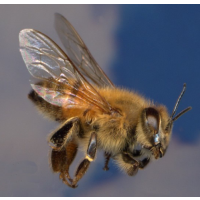Killer Bees Finally Arrive in Bay Area after 20 Years of Buzzing the Southland

Killer bees are invading the Bay Area and the Central Valley and scientists are hoping it turns out to be a good thing.
A report published by University of California, San Diego researchers in the September issue of PLOS One says the Africanized honey bees, which have been buzzing around Southern California since 1994, were recently detected in the north, and East Bay Regional Park District spokeswoman Carolyn Jones tried to reassure San Francisco Chronicle readers that there was little to fear.
“We don't think this is a threat to the public in any way,” she said. But then added an unsettling disclaimer: “But with climate change, anything is possible in the future.”
Africanized bees do better in warmer climates, which has led some professional beekeepers in the Bay Area to speculate that the cool temperatures and coastal moisture will prevent them for taking over. But it remains to be seen how an extended drought and global warming will alter the calculation.
People have been terrorized at the thought of being attacked by killer bees since they were first unleashed in Brazil in 1956 and headed for the United States. The Africanized honey bee is a hybrid of a European and African bee that was brought to South America to improve honey production. But some of them escaped into the wild and dominated the native bees as they bred and spread.
They are feared for their ferocity and considered more difficult to control in captivity because of their feral nature. Although Jones downplayed the current threat, UC Davis honeybee researcher Brian Johnson told the Chronicle they “are a public health threat” and people need to be educated about them.
A worker in Riverside died last month when a swarm of Africanized bees attacked a construction crew that got too close to their hive. Although around 40 people die annually from bee attacks in the U.S., there is no breakout of how many were Africanized bees.
Venom from the bees is the same as the meeker European bees that Americans are used to. But killer bees sting more often when they attack. They are also more likely to attack, sometimes taking umbrage at people or animals 500 feet from their hive.
One thing killer bees have going for them is hardiness. They appear to be more resistant to some diseases and parasites that bedevil European bees. The question is: how do they feel about pesticides?
Honeybees have been dying off in frightening numbers for a decade, posing a huge threat to California's agricultural production where pollination is critical. Land use and other factors are no doubt part of the problem, but pesticides have been one of the suspects from the beginning.
Earlier this month, the U.S. Ninth Circuit Court of Appeals in San Francisco, responding to a federal Earthjustice lawsuit, ruled (pdf) that the U.S. Environmental Protection Agency (EPA) erred when it approved the pesticide sulfoxaflor, and essentially ordered it off the market. The EPA admitted it was aware that sulfoxaflor was “very highly toxic” to bees, but reasoned that rules for its application could be devised that would mitigate any harm. The court said the EPA had no basis for saying that.
‒Ken Broder
To Learn More:
"Killer Bees" Found in the Bay Area for the First Time (by Kevin Schultz, San Francisco Chronicle)
Killer Bees Detected in Lafayette, Bay Area for First Time (by Matthias Gafni, Bay Area News Group)
Study Shows Africanized Bees Continue to Spread in California (by Kim McDonald, University of California, San Diego)
California's Killer Bees Are Spreading North (by Elizabeth Palermo, LiveScience)
U.S. Ninth Circuit Reverses EPA’s OK of Pesticide that Is Destroying Honeybees (by Ken Broder, AllGov California)
Range and Frequency of Africanized Honey Bees in California (by Yoshiaki Kono and Joshua R. Kohn, PLOS One)
- Top Stories
- Controversies
- Where is the Money Going?
- California and the Nation
- Appointments and Resignations
- Unusual News
- Latest News
- California Forbids U.S. Immigration Agents from Pretending to be Police
- California Lawmakers Urged to Strip “Self-Dealing” Tax Board of Its Duties
- Big Oil’s Grip on California
- Santa Cruz Police See Homeland Security Betrayal in Use of Gang Roundup as Cover for Immigration Raid
- Oil Companies Face Deadline to Stop Polluting California Groundwater





